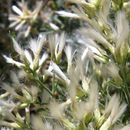en
names in breadcrumbs


The recognition of Baccharis emoryi as a separate species in other floras has been based on its wider, glabrous, eglandular leaves, more cylindric pistillate involucres, and dense whitish pappi. It was said to occur both west of the Rocky Mountains and in western Texas. In our study, expressions of the characters used to distinguish B. emoryi from other species were found to be inconsistent and inadequate to warrant recognition as a distinct species. There appears to be a complex of up to four species—emoryi, salicina, neglecta and angustifolia—that intergrade from west to east. Characteristics progress from broader leaves and larger heads (emoryi form of salicina) to narrow leaves with small heads (neglecta, angustifolia). The delimitation of taxa within this complex merits further investigation.
Baccharis salicina is a species of plant in the family Asteraceae. Common names include willow baccharis,[2] and Great Plains false willow.[3] It is a shrub found in North America where it grows in mildly saline areas.
Baccharis salicina is a shrub producing erect, branching stems approaching 4 metres (13 ft) in maximum height. The thick leaves are oblong to oval in shape and sometimes have roughly toothed edges. They may be up to 7 centimetres (2.8 in) long. The shrub is dioecious, with male and female plants producing flower heads of different types. The head is enclosed in a layer of phyllaries and the female flowers yield fruits, each an achene with a white pappus about a centimeter long.[3]
The earliest name for the species is Baccharis salicifolia Nutt., coined in 1840.[4] This name, however, had previously been used for some South American material,[5] so the North American plants needed to be renamed as Baccharis salicina.[6]
The plant is native to the United States (southern Great Plains region and Southwestern United States; states of California, Nevada, Arizona, Colorado, Kansas, New Mexico, Oklahoma, Texas, and Utah[7][8] and northern Mexico (Baja California, Chihuahua, Coahuila, Nuevo León, Durango, Sonora).[3][9]
The plant grows on open sandy flood plains, most commonly in mildly saline areas.[10]
Baccharis salicina is a species of plant in the family Asteraceae. Common names include willow baccharis, and Great Plains false willow. It is a shrub found in North America where it grows in mildly saline areas.